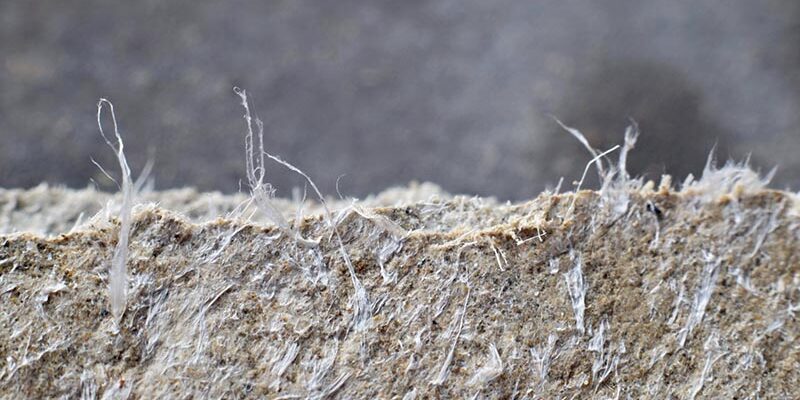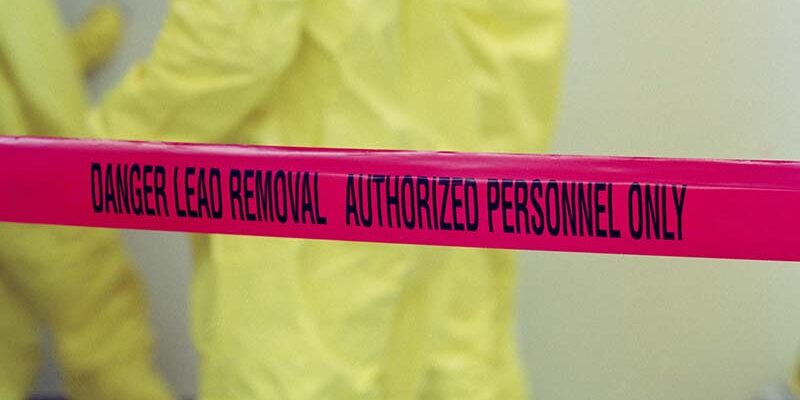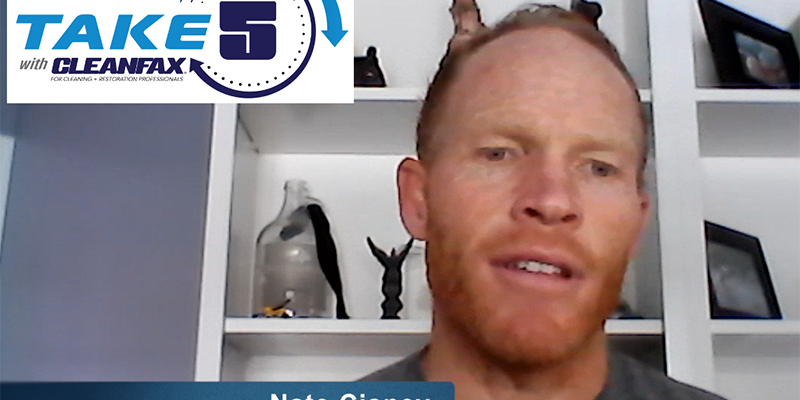Remediation for Hypersensitive Individuals

By Cleanfax staff
Roughly 80 million people in the United States suffer from sensitivities that make it difficult for their bodies to detox mold and microbial toxins. For these people, the mainstream approach to mold remediation will not suffice. Cleanfax recently talked with Michael Rubino, president of All American Restoration Corp., which specializes in remediation for hypersensitive clients, about the key points of working with this subsect of the population and the specialized practices needed to tailor remediation for their health and wellness.
Cleanfax staff (CF): Who are hypersensitive individuals? What makes a person more sensitive to mold or biotoxins than other people?
Michael Rubino (MR): Hypersensitive individuals are immunocompromised. The biggest classifications are chronic inflammatory response syndrome (CIRS), Lyme disease, PANS [Pediatric Acute-onset Neuropsychiatric Syndrome], PANDAS [Pediatric Autoimmune Neuropsychiatric Disorders Associated with Streptococcus], and Autoimmune Disorder. Those are the bigger classifications. There are other smaller ones, too.
If you add up the individuals with known diagnoses of these conditions, it equates to nearly 40% of the population. It’s interesting, when you go to houses with, say, a family of four, it’s typically one or two out of four are experiencing the symptoms. The other family members are not. It’s interesting because they have different viewpoints, different realities of what’s happening. What makes them sensitive over the rest of the family is that their immune system is already fighting other things, so the mold just completely overloads their systems. This ultimately prevents them from detoxifying as someone with a healthy immune system would.
CF: What effects do mold biotoxins have on hypersensitive clients?
MR: There’s a wide range of things that can occur, but the more common ones are allergy-like respiratory symptoms and constantly feeling like you’re about to get a cold. There’s also chronic headaches, chronic fatigue, brain fog, and other cognitive difficulties—depression, slowed and slurred speech, difficulty breathing. Hives can also occur. It’s going to depend on the species present. Certain species are going to be toxigenic, others allergenic, and others pathogenic. They have different effects on an individual depending upon the species present and the individual’s immune system.
CF: How do the remediation steps on this type of work differ from standard remediation?
MR: This is something I’m very passionate about. The industry standards cover removing the sources of mold or active growth. There’s no difference there, as the standards and guidelines all include protocols for how to remove sourcing. What’s different about what we do for hypersensitive clients is we also handle the contamination created by those sources. It’s a much more involved and thorough process.
Say there is mold growing around a window where water entered; that is the source because it’s what is actively producing spores and biotoxins that damage the environment. Resolving that source by setting up containment and engineering controls and performing industry standard protocols to address that is all standard and commonly handled by any licensed and certified mold remediator.
The standards however, lack clear protocols to clean up the contamination created by those sources. That’s where the problem we experience lies. If you have Stachybotrys around that window and it’s producing trichothecene mycotoxins and mold spores, those spores and mycotoxins continuously produce into the environment.
This typically will impact the HVAC system because it continuously draws air through the returns, conditions it, and supplies it back out. A lot of HVAC systems don’t have the proper filtration to protect the unit from a mold spore that are .02 microns in size, so mold passes right through the filter and gets into the unit. The HVAC coil condensates, providing a wet environment for mold to be able to grow. This process can turn the HVAC system into a source as well.
This is why neglecting to clean up mycotoxins and mold spores from a home after the sources are remediated is a problem in my opinion. In most cases, contamination shown in MSQPCR testing as well as mycotoxin testing is ignored entirely. Let’s say there is a leak from a bathtub drain resulting in mold growth, prompting an insurance claim. The insurance company will cover removal of the source in the bathroom, but nine times out of ten they will not acknowledge the contamination present in the HVAC system or adjacent rooms as shown in MSQPCR testing no matter how obvious that these were impacted. If mycotoxins are also present because the molds present from the tub leak produced mycotoxins, they also may not acknowledge that.
The whole mantra of insurance companies is: “Peter from Company X said he can do the whole job for half the price.” What they leave out is Peter from Company X is doing it for half the price because he’s doing half the work. To top it off, the insurance company will not only push homeowners to use Company X to remediate, but also will push them to use their preferred testing contractor to validate Peter’s work was adequate. This will include basic baseline testing that won’t check to see if any of the contamination by that source was resolved properly. I think that’s another systemic problem of our industry because it’s just completely being ignored, and we as professionals allow it to happen.
Our company has developed protocols to handle that. We offer a full guarantee that we will remove the mycotoxins, endotoxins, and spore accumulation created by the sources in the home. Basically, the main difference is industry standard protocols stop at removing the source, and that’s not going to be enough for somebody who’s sensitive. You actually have to deal with the contamination that those sources created.
CF: Do the insurance companies work with you on that?
MR: Yes and no. It depends on the situation. In the past, we’ve had adjusters who understand and genuinely wanted to help the client. Because each insurance company is represented by an adjuster, the adjuster is ultimately the one who’s going to decide if whether to cover it. If the adjuster wants to be a hero and save money for his insurance company, he’s going to utilize the tools they have to fight it. We’ve had insurance companies hire an industrial hygienist on the West Coast for a claim in New Jersey to say, “The EPA states MSQPCR data is experimental only and cannot be used to diagnose problems in a house,” which is interesting.
I get the scoring methodology is experimental, but when you look at an MSQPCR analysis, it’ll tell you, for example, there are 150 spores of Stachybotrys present; there’s 2,000 spores of Aspergillus present; etc., listing 36 different molds, telling you which are present and how much were found. It tells you which molds are considered indoor water damage molds and which molds are common outdoor molds. What’s interesting is the data of how many spores are actually present, that’s not experimental; that’s data. I agree the scoring methodology is off. It doesn’t make sense. But having the data to say there are still 150 spores of Stachybotrys in the environment is useful data. It tells us the place still needs to be cleaned, and that’s not experimental at all.
It’s disheartening because so many families are faced with these components, and if you’re sensitive, yes, your bathroom is now clean, but you have 150 spores accumulated across your house that are going to get into your breathing zone and enter the body. That’s why these people are still experiencing symptoms even after remediation because, obviously, the contamination is still there. That’s part of the problem with the industry, and nobody’s really banding together. It’s almost separated the industry into two sides: One side agrees; the other wants to stick to the status quo. We’re really pioneers trying to help change things, but it’s a slow, steady process.
CF: What would you say are common mistakes to avoid?
MR: I’ve come up with basically eight common remediation mistakes.
Number one is improper engineering controls. What that means is somebody will come in and slap plastic up and cover an opening, and if they don’t contain it properly, don’t use the right plastic, don’t use any pole supports to hold that plastic up, the containment is going to fall down overnight.
Another problem with engineering controls is, let’s say you’re working in a space and need to do negative pressure, but there’s no window to draw air outwards; the solution is to create positive pressure outside the containment so, when you’re working inside, that area does not cross-contaminate the space outside of it. What I’ve seen too often is remediation companies just set up an air scrubber inside the work zone and think they’ve setup engineering controls properly. What they’ve inadvertently done is setup an air scrubber under neutral pressure, but the air can still circumvent into other areas of the home.
The number two problem is not removing enough building materials. Let’s say you have a water leak and the water affects six square feet of drywall and the company removes four square feet. You still have two square feet of drywall potentially harboring mold. You’re supposed to go four feet beyond water damage. I go into a project sometimes where we’re the second company coming in (someone already “remediated it”), and we see signs of water damage that went further than what was removed. That’s why it’s still showing up in post testing, so it’s a no-brainer for us to go further to ensure we don’t miss anything.
The number three thing we run into a lot is not drying out wet building materials. There’s a multitude of potential problems here, but imagine there’s a water event and a company cuts out the drywall 2 feet off the floor, thinking that’s good enough because there was only ¼ inch of water. The problem with that is water on the floor is going to wick up the wall. Drywall is a permeable building material that absorbs water. Maybe the water itself never got 2 feet high, but it’s possible for the water to wick up past 2 feet. That’s why having a moisture meter on hand, making sure you go past the moist material is a must.
The number four problem comes when restorers don’t dry out wet building materials between phases. Let’s say you’re treating a wall cavity with an antimicrobial agent and don’t allow that to properly dry before spraying a paint-based encapsulant on top. One problem is you’re now keeping moisture locked into the building material, which is a perpetual issue for mold and can also degrade the material over time. Another issue is you now have two compounds mixed together. Depending on the products, you may combining chemicals that mix together and create a toxic off-gas. So, it’s really important to always follow manufacturer recommendations and make sure everything is dried properly before you move from phase to phase.
The number five common mistake is not removing mold from surfaces. Time and time again we see companies say, “We killed it by spraying it.” That’s not how it works. All guidelines including the IICRC S520 say you have to use abrasive methodology to remove mold from the building material before you spray it with an antimicrobial. An antimicrobial is supposed to be a kind of failsafe after you’ve physically removed the hyphae from the building material. If you see mold on wood and just spray a chemical and wait for it to dry, you’re not physically removing the mold from the building material. Likely you’re going to let that dry, and then paint over mold. So, there’s a misconception that you can apply these products to “kill” the mold and you’re good to go after that. You do need to use abrasive methodology to remove the hyphae from the building material to ensure there’s no potential for the mold to come back. This is why I never feed into the “magic products” that come on the market. You have to do the work to get the results.
Number six is residual dirt, dust, and construction debris. For example, we were the second company in on a project where the previous company removed all the walls surrounding the bathtub but left the tub in place. It looked like a decent job on the surface until you looked between the bathtub and wall cavity. We could see all this dirt and debris at the bottom of the wall cavity.
What that tells you is A) They didn’t treat that wall cavity properly; B) They just tried to encapsulate over all the debris—and the encapsulation process doesn’t work if you’re encapsulating over debris; C) Obviously, if there’s debris, there’s still going to be mold because mold is microscopic at that level. It’s always important to make sure you vacuum all debris and any possible mold particulates before you treat and encapsulate.
Number seven: When doing the actual fine particulate remediation, you’re going to be using microfiber towels to actually remove the contamination from the building or the home, and not using enough rags to clean the surface is a problem. It’s kind of like mopping your floor without cleaning out the mop head every so often; you’re just going to be mopping dirt all over the place. It’s the same concept. If you don’t use enough rags to clean up, you’re just going to be moving mold and dirt around the room. You’re not actually going to be removing it.
The number eight problem, which I’ve touched on, is encapsulating over debris. If you encapsulate over mold and debris, you’re not encapsulating properly. It’s supposed to be a monolithic surface on the actual structure that you’re trying to protect. Not bonding to a clean surface is going to ruin the performance of the product. It also traps mold spores with the debris, which could become an issue should the conditions become possible for mold to grow again. Just using an antimicrobial product doesn’t prevent mold from growing if you’ve allowed it to stay there.
CF: Are there special training requirements for working with hypersensitive clients?
MR: Shockingly enough there are no special licensing requirements other than the standard certification needed to perform water damage or mold remediation. In my opinion, there needs to be a separate certification that expands on the initial protocols and is geared toward hypersensitive clients. There should be an optional certification set up so that mold remediation companies with an interest in helping sensitive people can get the training and certification to do so and so when a person is known to be hypersensitive, they can find a contractor who knows how to service them. There could very easily be a training program setup to accompany the certification, similar to the training programs already in place.
The hypersensitive population is severely underserved, with a lack of companies offering the same technology as us. Because of this, we have traveled as far as Reno, Nevada (from New Jersey) to help them. Some of our clients have told us companies respond to their known sensitivities with, “We don’t service people who are sensitive.” It’s kind of like saying, “We don’t know how to remove the mold fully, so if you’re sensitive, we think you’re going to be a headache and we won’t service you.”
I think it’s a systemic problem in our industry that professionals view someone who is sensitive as “crazy” or a “problem.” The truth is they are sensitive and require a higher standard than what’s currently offered. The IAQA is launching an industry education platform I think is a great place to start. We did mention this topic to them. Hopefully, after things calm down in the world, that could be further discussed.
CF: Is there anything else you think is important to share?
MR: I’m very passionate about creating awareness of the need for a more thorough approach to mold remediation. Because our industry as a whole has been using the same protocols for 20 years, it’s tough to change, but we have been making great strides. Our business grows every year because more people are realizing the impact it has on their family’s health and sees the importance of going above and beyond industry standards to ensure their home has a perfect ecology.
I think really what we need to do is start questioning whether there is a subset of the population that’s being underserved and ignored. Is there a need for this? Based upon the statistics and research we’ve done and just how our business has grown, I think there is a need for it. There’s a great demand that hypersensitive clients have, and I think we need to take a look at that as professionals and figure out how we can be of better service to them.












